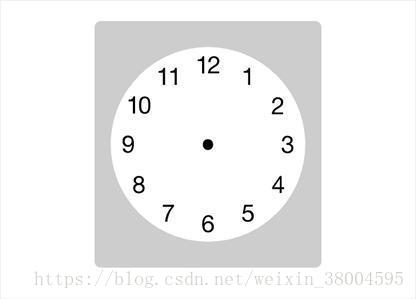JavaScript实现仿Clock ISO时钟
web前端学习圈 人气:0来模仿一个 ISO 上的时钟:ISO Clock
实现效果:

ISO Clock
项目分析
1、首先时钟嘛,肯定要获取本地客户端的时间;
2、时钟有 3 个指针,我们可以通过添加动画的方式让它们围绕中心点转动;
3、通过获取到的 hour、minute 和 second 值分别计算 时针、分针和秒针的角度值;
HTML&CSS
布局
<div class="box"> <article class="clock"> <div class="hours-container"> <div class="hours"></div> </div> <div class="minutes-container"> <div class="minutes"></div> </div> <div class="seconds-container"> <div class="seconds"></div> </div> </article> </div>
1、.box 是为了布局的方便;
2、 然后每个指针都需要一个 *-container 容器 。
添加 CSS 样式
把背景加载进来,然后放在页面中合适的位置上。
html{ font-size: 10px;
}html,body{ margin: 0; padding: 0;
}.box{ width: 35rem; height: 38rem; background: rgb(205,205,205); border-radius: 1rem; margin: 5% auto; display: flex; justify-content: center; align-items: center;
}.clock{ width: 30rem; height: 30rem; background: #fff url(ios_clock.svg) no-repeat center; background-size: 88%; border-radius: 50%; position: relative;
}

1、 width: 35rem; height: 38rem; 这个比例比较顺眼吧;
2、 .box 使用 Flex 布局方式,并且使其中的 .clock 水中、垂直方向都居中。看过第一天教程应该都明白 Flex 布局的。
3、Clock 的背景使用一张图片。获取地址
添加中心轴
使用 CSS3 中的 伪元素 为时钟添加实心小圆点,指针都围着这个点转。
.clock:after{ content: ''; width: 1.5rem; height: 1.5rem; background: #000; border-radius: 50%; position: absolute; top: 50%; left: 50%; transform: translate(-50%,-50%); /* 向左上移动自身的50% */
z-index: 10;
}

1、 这句 content: ''; 是必须的,不然这个伪元素不会显示,即使指定了宽度和高度。
2、 由于相对定位是从元素的左上角开始计算的,所以 top: 50%; left: 50%; 不能使这个小圆点在 Clock 的中心,使用 transform: translate(-50%,-50%); 向左上方移动自身宽度或高度的 50%
3、 z-index: 10; 是为了使这个小圆点在视图的最上层,遮挡住指针交叉的地方
指针容器
.hours-container,.minutes-container,.seconds-container{ position: absolute; top: 0; right: 0; bottom: 0; left: 0;
}
1、容器被放置在 Clock 的上方,但是并没有样式,接下来就可以创建指针了!
添加指针
.hours { width: 3%; height: 20%; background: #000; transform-origin: 50% 100%; position: absolute; top: 30%; left: 48.5%;
}.minutes { width: 2%; height: 37%; background: #000; transform-origin: 50% 100%; position: absolute; top: 13%; left: 49%;
}.seconds { width: 1%; height: 40%; background: #f00; transform-origin: 50% 90%; position: absolute; top: 20%; left: 49.5%; z-index: 8;
}

1、分别添加时针、分针和秒针。
2、 使用 % 这种单位可以更好地适应不同的屏幕。
3、transform-origin: 50% 90%; 规定指针旋转的位置为:X 方向的中心线 和 Y 方向的 90% 处这条线的交叉点。(具体看图吧)

4、 这里在定位的时候把自身的宽度计算在内了,所以就不必在往左上角移动了。
动画
目前为止,这个 Clock 还是没有功能的,我们来让它动起来。
定义动画规则
@keyframes rotate {
100% { transform: rotateZ(360deg);
}
}
1、这里用 @keyframes 规则定义了一个动画,这个动画的名称是 ratate ,应用这个动画的元素会沿着某个 Z 轴(也就是上面规定好的哪个交叉点)旋转 360 度。
定时功能
规定每个指针旋转 360 度需要多长时间。
.hours-container { animation: rotate 60s infinite linear;
}.minutes-container { animation: rotate 30s infinite linear;
}.seconds-container { animation: rotate 10s infinite linear;
}

为了演示方便,这里固定的时间并没有按照真实的 Clock 来设置。时针应该是 12 小时(43200s)、分针应该是 3600s 、秒针应该是 60s 。
更像真实的 Clock
现实中的 Clock 大部分是秒针和分针都是会跳动的,并且伴随着滴答声,我们来尝试一下。
.hours-container { animation: rotate 60s infinite linear;
}.minutes-container { animation: rotate 3600s infinite steps(60);
}.seconds-container { animation: rotate 60s infinite steps(60);
}

1、只需要将 分针 和 秒针的旋转方式调整为 steps() 即可。
但是这样的 Clock 每次刷新都是从 0 开始的,并不是我们需要的,怎么做一个显示真实时间的呢??
正确的时间
我们首先要获取到当前的时间,然后计算每个指针应该旋转的角度即可。
获取每个指针
const hourHand = document.querySelector('.hours-container');const minuteHand = document.querySelector('.minutes-container');const secondHand = document.querySelector('.seconds-container');
获取当前时间
const now = new Date();const hour = now.getHours();const minute = now.getMinutes();const second = now.getSeconds(); `
计算每个指针应旋转的角度
在 CSS3 中角度单位一共有四种:
- deg (度,一个圆 360 度)、
- grad(梯度,一个圆共400梯度)、
- turn (转、圈,一个圆共1圈)、
- rad (弧度,一个圆共2π弧度)
- 它们的对应关系为:
90deg = 100grad = 0.25turn ≈ 1.570796326794897rad
很显然,我们这里要用到的单位是 deg 。
const secondDegree = second * 6 + 90; const minuteDegree = minute * 6 + (second / 10) + 90; const hourDegree = (hour * 30) + (minute / 2) + 90;
1、+90 是因为角度的起始位置为水平的 X 轴,为了和 Clock 指针起始位置(Y 轴)做统一;
2、秒针的计算最简单,(second / 60) * 360 + 90;
3、 分针要考虑秒针的影响,如过了30秒,相当于半分钟。公式为: 当前分钟数 + 秒数在分钟的映射;即:(( minutes/ 60) * 360) + ((seconds / 60) * 6) + 90;
4、 时针稍微复杂一点,因为要考虑分钟的影响,如过了30分钟,相当于半小时。公式为: 当前时数 + 分钟在小时的映射 。即:(( hours/ 12) * 360) + ((minutes / 60) * 30) + 90;
应用角度值
hourHand.style.transform = `rotateZ(${hourDegree}deg)`;
minuteHand.style.transform = `rotateZ(${minuteDegree}deg)`;
secondHand.style.transform = `rotateZ(${secondDegree}deg)`;
为了使页面能实时的更新,我们要把上面的这些东西封装为一个函数,然后用定时器每秒执行一次。
整个时钟的功能都完成了!
加载全部内容